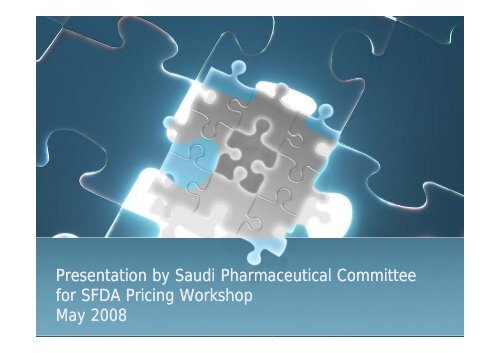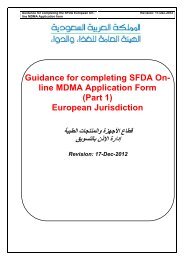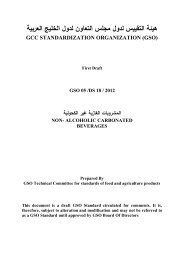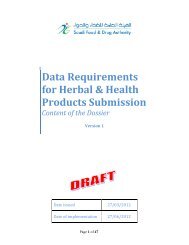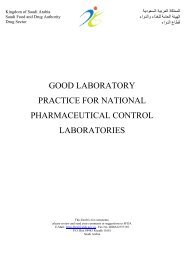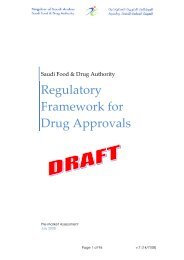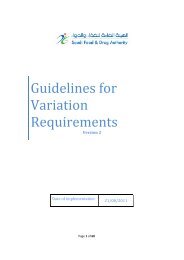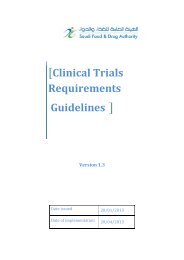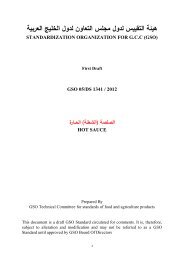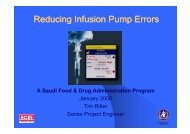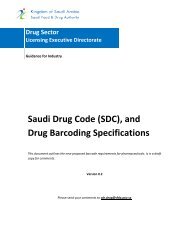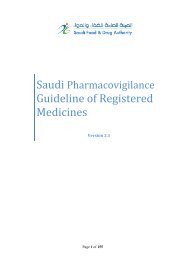Presentation by Saudi Pharmaceutical Committee for SFDA Pricing ...
Presentation by Saudi Pharmaceutical Committee for SFDA Pricing ...
Presentation by Saudi Pharmaceutical Committee for SFDA Pricing ...
- No tags were found...
Create successful ePaper yourself
Turn your PDF publications into a flip-book with our unique Google optimized e-Paper software.
<strong>Presentation</strong> <strong>by</strong> <strong>Saudi</strong> <strong>Pharmaceutical</strong> <strong>Committee</strong><strong>for</strong> <strong>SFDA</strong> <strong>Pricing</strong> WorkshopMay 2008
Estimated size of healthcare market SR 49.0 billionSource : <strong>Saudi</strong> healthcare service sector review infocus report Dec. 2007
Estimated size of healthcare market SR 49.0 billionKingdom’s expenditure on pharmaceuticals isSR 8 billionSource : <strong>Saudi</strong> healthcare service sector review infocus report Dec. 2007
Estimated size of healthcare market SR 49.0 billionKingdom’s expenditure on pharmaceuticals isSR 8.0 billion<strong>Saudi</strong> pharmaceutical market imports 85% of the total market demandOnly 15% satisfied <strong>by</strong> the local pharmaceutical productionSource : <strong>Saudi</strong> healthcare service sector review infocus report Dec. 2007
Estimated size of healthcare market SR 49.0 billionKingdom’s expenditure on pharmaceuticals isSR 8.0 billion<strong>Saudi</strong> pharmaceutical market imports 85% of the total market demandOnly 15% satisfied <strong>by</strong> the local pharmaceutical productionPublic sector accounts <strong>for</strong> 77% of total healthcare outlays.And it’s not affected <strong>by</strong> pricing policy as it depends mainly ontender business. Only 23% is affected <strong>by</strong> pricing policy.Source : <strong>Saudi</strong> healthcare service sector review infocus report Dec. 2007
Estimated size of healthcare market SR 49.0 billionKingdom’s expenditure on pharmaceuticals isSR 8.0 billion<strong>Saudi</strong> pharmaceutical market imports 85% of the total market demandOnly 15% satisfied <strong>by</strong> the local pharmaceutical productionPublic sector accounting <strong>for</strong> 77% of total healthcare outlays.And it’s not affected <strong>by</strong> pricing policy as it’s depend mainly on tender.Only very slim area is affected <strong>by</strong> pricing policyHighly fragmented industrySource : <strong>Saudi</strong> healthcare service sector review infocus report Dec. 2007
Conclusion• Local manufacturers competing in 15% ofthe market,• Highly fragmented market.• Impact of pricing on local products does nothave a large impact on the total healthcarebill.• Government tenders and insurancecompanies have significantly reduced thecost of healthcare.• <strong>Saudi</strong> <strong>Pharmaceutical</strong> product have a goodperception <strong>by</strong> the medical profession.
Contents• Current situation• Needs, and suggestions
Current situation feedback• The first generics coming tomarket obtain the highestmarket share while othersregistered after haveinsignificant market share.• The patient and thecompany do not benefitfrom the continuous pricereduction.First , and second Azithromycingeneric have the lions shareFirst Amlodipine genericHave lions shareazithromycin generics45000004000000AZI-ONCE3500000ZIMAX3000000ZETRON2500000ZOCIN2000000AZOMAX1500000AZOMYCIN1000000AZIMAC50000002008140000001200000010000000AMVASC8000000 AMLOPINEVASCO DIPINE6000000AMOPRESSLOWVASC4000000200000002008
Current situation feedbackUnclear pricing• Unable to <strong>for</strong>ecast eventual pricing i ofgenerics, as ranking of product isunknown and there<strong>for</strong>e price isunknown.• Unsure if company will recoupinvestment in R&D, and bioequivalentstudies. ( investments that can reachSr. 1 million)
Current situation feedbackNot competitive• It’s unattractive <strong>for</strong> any yppharmaceuticalmanufactures to establish new generic plant in <strong>Saudi</strong>Arabia:• Massive reduction in the cost of their generics as they willnot be in the top three.• Low prices given will limit their export to neighboringcountries.• Strategy limited to new generics and me too strategy.
Current situation feedbackRe-pricing• Cost of production continues to increase, affected <strong>by</strong>inflation. Government body requested to reduce theprices further in 2007.• Exchange rate increased from 45 to 60%. Theimported materials, packaging materials increased atthe same level, while our prices were reduced.• Imported product prices increased due to revaluationof exchange rate. Local products were not revalued.
Current situation feedbackQuality• <strong>Pricing</strong> not linked to quality but linkedto who comes first.• Resulting in a race to register first.
Current situation feedbackTransparency• No representatives from the localpharmaceutical industry, or endcustomers in the pricing andregistration it ti committee.• No communication or transparency onproducts under registration and theirstatus.
Needs• Needs regarding generics‣ Suggestion‣ Rationale behind suggestions.• Needs regarding second db brand d( (underlicense)‣ Suggestion‣ Rationale behind suggestions
Needs – generics• To create a pricing policy based onquality, transparency and equalbenefits <strong>for</strong> both local manufactures aswell as the end user.• how
SuggestionsGenerics• Start the registration process with the pricing committee.• The first generic allowed to have a price 20% lower than theoriginator. The second generic and thereafter free to chooseany price lower than the first generic.• <strong>Pricing</strong> should be revised <strong>for</strong> all existing brands irrespective ofwhen they enter the market. Free pricing after reduction of20% from originator.i • Apply price revision <strong>for</strong> the generic (local) every three years tomatch the change in market dynamics and inflation.• Representatives ti from the industry to have a seat in the pricingicommittee.• Transparency in registration of products. Easy and clear accessto all products under registration as well as their status. Poston web site all products under registration, showing stages,and already registered.
The rationale• Price in <strong>Saudi</strong> Arabia is considered <strong>for</strong> export market. Lowprices given, limit the potential <strong>for</strong> export. Free pricing willenable local companies to export.• Newly established local factories will have equal pricingopportunities. Encouraging higher investment and quality.• Local manufacturers can <strong>for</strong>ecast sales strategy andinvestment. t Better strategies t and a clear vision.i• Local manufacturers can focus on niches and quality.• Create competition, allowing companies to have right pricepositioning.i• Encourage focus on quality.• Clear communication between government and industry.Transparent pricing i and registration tiprocess.
Needs, and suggestionsUnder license• <strong>Pricing</strong> of Under-licensed products should bethe first phase of registration.• Co-marketing is an attractive tool to promoteunder license agreements. However thecurrent regulations <strong>for</strong> second brand is notencouraging as;• It requires a 10% price reduction of second brandfrom originator.• Propose to have the second brand andoriginator to have the same price and launchat the same time.
Rationale behind suggestions• Potential to shift imported products to local<strong>for</strong>mulation.• Increasing availability of products• Boosting local production• Securing quality• Transfer of know how• Etc.• The current 10 % difference is not significantto the end user.
Clear, Transparent and FairIncrease Exports Increase local production Improve quality


